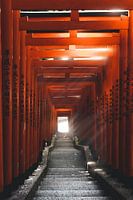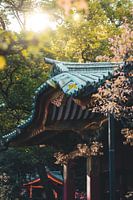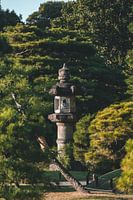Buy this landscape artwork Roof beams of a Japanese temple by Endre Lommatzsch on canvas, ArtFrame, poster and wallpaper, printed on demand in high quality.
About "Roof beams of a Japanese temple"
by Endre Lommatzsch
About the artwork
Japanese temples are important places of spirituality and culture that are deeply rooted in the country's history and tradition. They serve not only as places of religious devotion, but also as oases of peace and contemplation.
Most temples in Japan belong to the Buddhist tradition, with each school and school of thought cultivating its own architectural features and rituals. The central elements of a temple often include a main hall (hondō), in which the main figure of worship - such as Buddha or a bodhisattva - is enshrined, as well as a tori-like entrance gate, pagodas and well-tended gardens.
A visit to a temple usually begins with a ritual purification process. At a water point (chōzuya), you cleanse your hands and rinse your mouth to purify your body and mind. You can then pray, light an incense candle or make an offering in the wooden box in front of the main hall.
Many temples also offer omamori (lucky charms), omikuji (lucky cards) or other spiritual souvenirs to bring protection and prosperity to visitors.
In addition to their religious significance, temples are also impressive cultural monuments that give visitors an insight into the architecture, art and history of Japan. They invite you to pause, reflect on the essentials and enjoy the beauty of the surroundings - be it during a tea ceremony or while exploring the often magnificent grounds.

About Endre Lommatzsch
Hey, I'm Endre!
I was born in Budapest and now live in Mainz - and I'm neither a full-time photographer nor a travel influencer. My actual profession and my passion couldn't be more different. A few years ago, I grabbed my rucksack and my camera (which was almost 20..
Read more…
 Germany
Germany Ordered in March 2024
Ordered in March 2024
 Netherlands
Netherlands Ordered in August 2024
Ordered in August 2024
 Netherlands
Netherlands Ordered in December 2023
Ordered in December 2023
 Netherlands
Netherlands Ordered in May 2025
Ordered in May 2025
 Germany
Germany Ordered in April 2019
Ordered in April 2019
 Germany
Germany Ordered in January 2025
Ordered in January 2025
 Netherlands
Netherlands Ordered in January 2025
Ordered in January 2025
 Germany
Germany Ordered in November 2024
Ordered in November 2024
 Netherlands
Netherlands Ordered in November 2020
Ordered in November 2020
 Netherlands
Netherlands Ordered in November 2022
Ordered in November 2022
 Netherlands
Netherlands Ordered in February 2018
Ordered in February 2018
 Netherlands
Netherlands Ordered in January 2022
Ordered in January 2022
About the material
ArtFrame™
Interchangeable Art Prints
- High-quality print
- Easily interchangeable
- Acoustic function
- Large sizes available
Discover the artworks of Endre Lommatzsch
 Sunset at the Tokyo Sky TreeEndre Lommatzsch
Sunset at the Tokyo Sky TreeEndre Lommatzsch Japanese torii gates in the evening sunEndre Lommatzsch
Japanese torii gates in the evening sunEndre Lommatzsch Maneki-neko as far as the eye can seeEndre Lommatzsch
Maneki-neko as far as the eye can seeEndre Lommatzsch View of ManhattanEndre Lommatzsch
View of ManhattanEndre Lommatzsch Morning walk on the Brooklyn BridgeEndre Lommatzsch
Morning walk on the Brooklyn BridgeEndre Lommatzsch Radio City Music HallEndre Lommatzsch
Radio City Music HallEndre Lommatzsch a young lion and his mother I/IIIEndre Lommatzsch
a young lion and his mother I/IIIEndre Lommatzsch a young lion and his mother II/IIIEndre Lommatzsch
a young lion and his mother II/IIIEndre Lommatzsch Lucky cards in JapanEndre Lommatzsch
Lucky cards in JapanEndre Lommatzsch Tori gates in Japanese templesEndre Lommatzsch
Tori gates in Japanese templesEndre Lommatzsch Japanese temple complexEndre Lommatzsch
Japanese temple complexEndre Lommatzsch Japanese temple gardenEndre Lommatzsch
Japanese temple gardenEndre Lommatzsch Lucky cards in JapanEndre Lommatzsch
Lucky cards in JapanEndre Lommatzsch Brooklyn Bridge: A landmark through the agesEndre Lommatzsch
Brooklyn Bridge: A landmark through the agesEndre Lommatzsch Hyena: The underestimated predatorEndre Lommatzsch
Hyena: The underestimated predatorEndre Lommatzsch Malta - the historic pearl in the MediterraneanEndre Lommatzsch
Malta - the historic pearl in the MediterraneanEndre Lommatzsch Malta - the historic pearl in the MediterraneanEndre Lommatzsch
Malta - the historic pearl in the MediterraneanEndre Lommatzsch Malta - the historic pearl in the MediterraneanEndre Lommatzsch
Malta - the historic pearl in the MediterraneanEndre Lommatzsch Malta - the historic pearl in the MediterraneanEndre Lommatzsch
Malta - the historic pearl in the MediterraneanEndre Lommatzsch The rugged island of FuerteventuraEndre Lommatzsch
The rugged island of FuerteventuraEndre Lommatzsch













 Countries & Travel
Countries & Travel Elegant Expressions
Elegant Expressions Japan
Japan Landscapes
Landscapes Mysterious Spheres
Mysterious Spheres Photo wallpaper
Photo wallpaper Photography
Photography Serene Peace
Serene Peace Temple
Temple Tokyo (city)
Tokyo (city)









